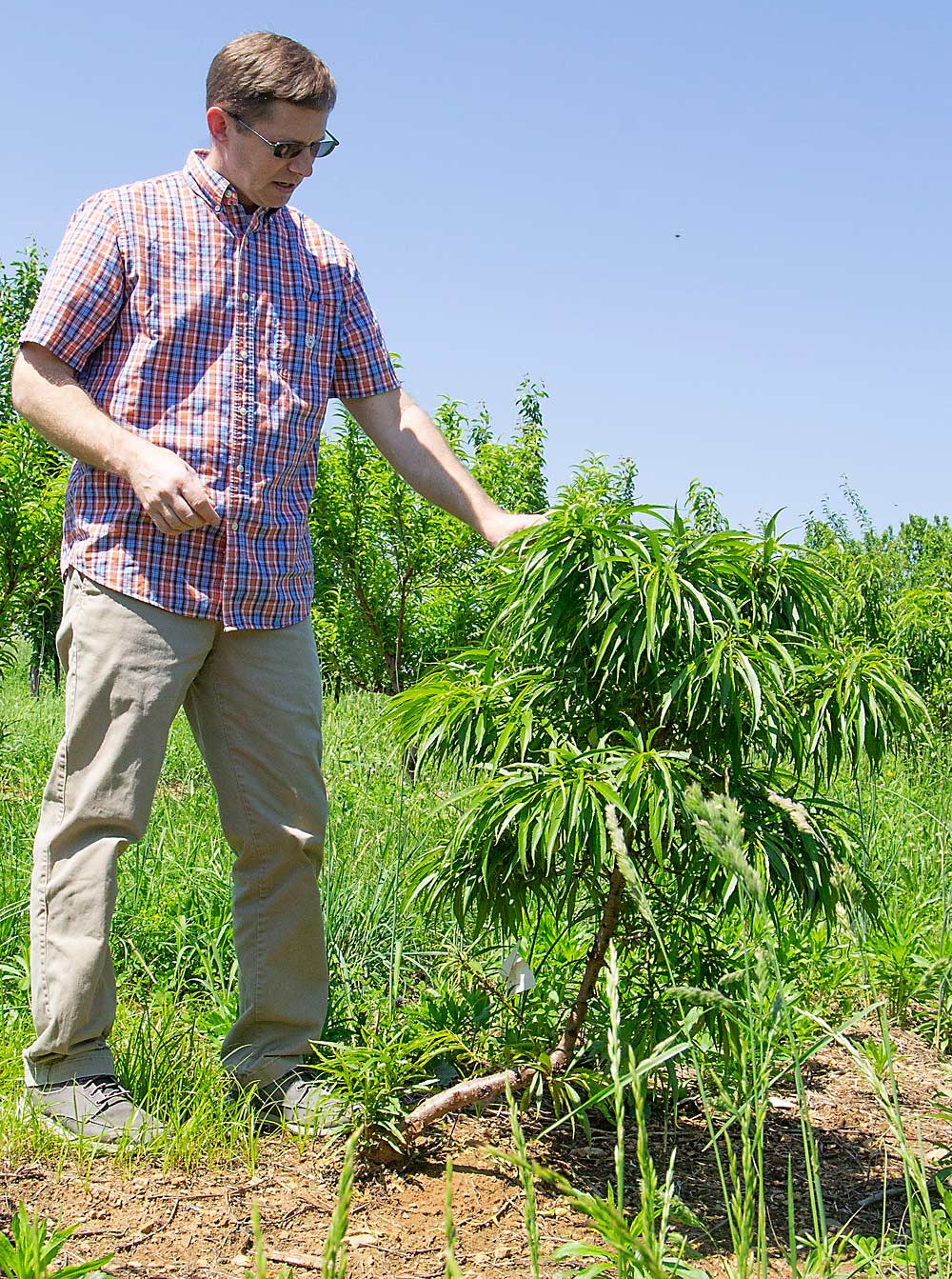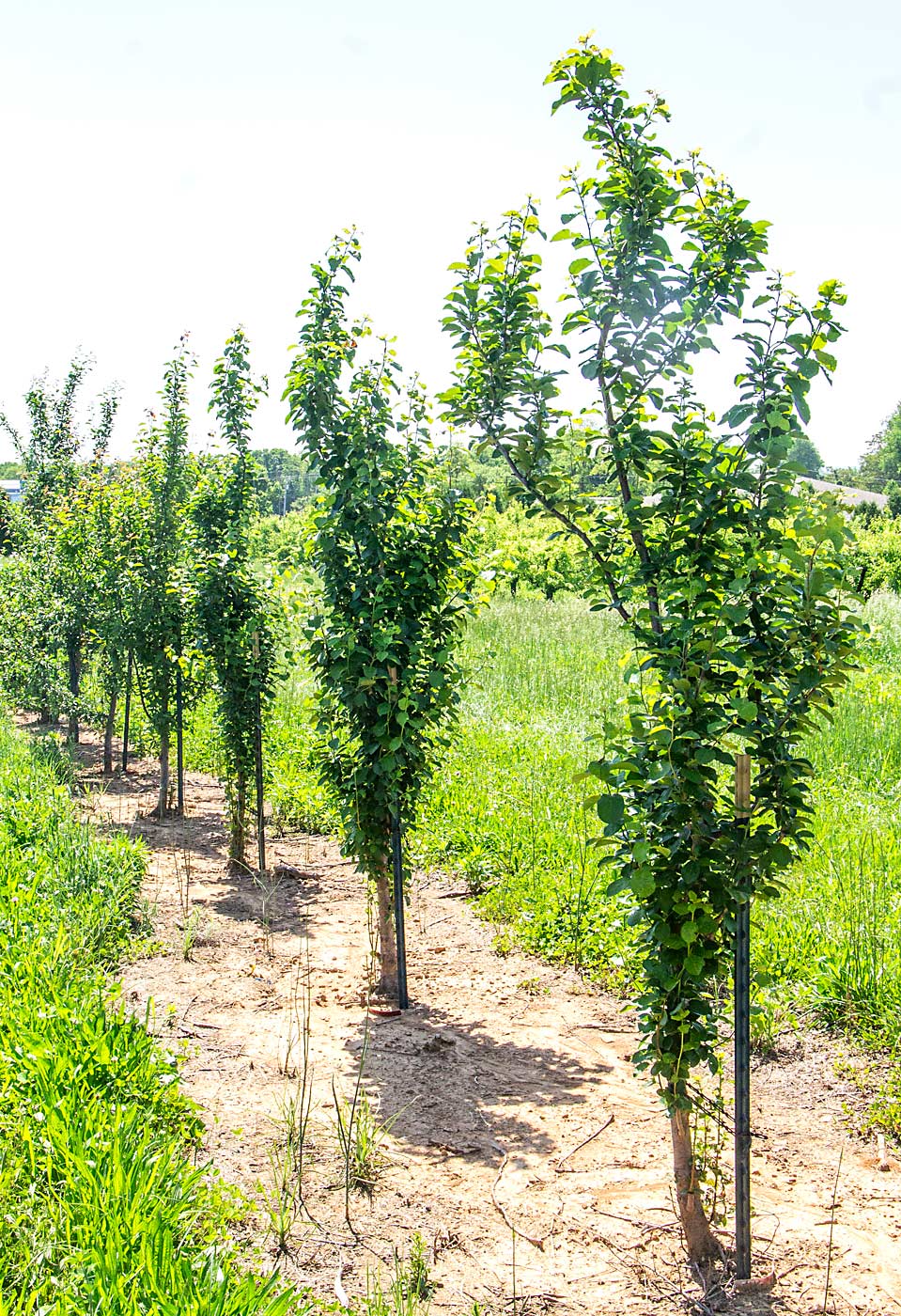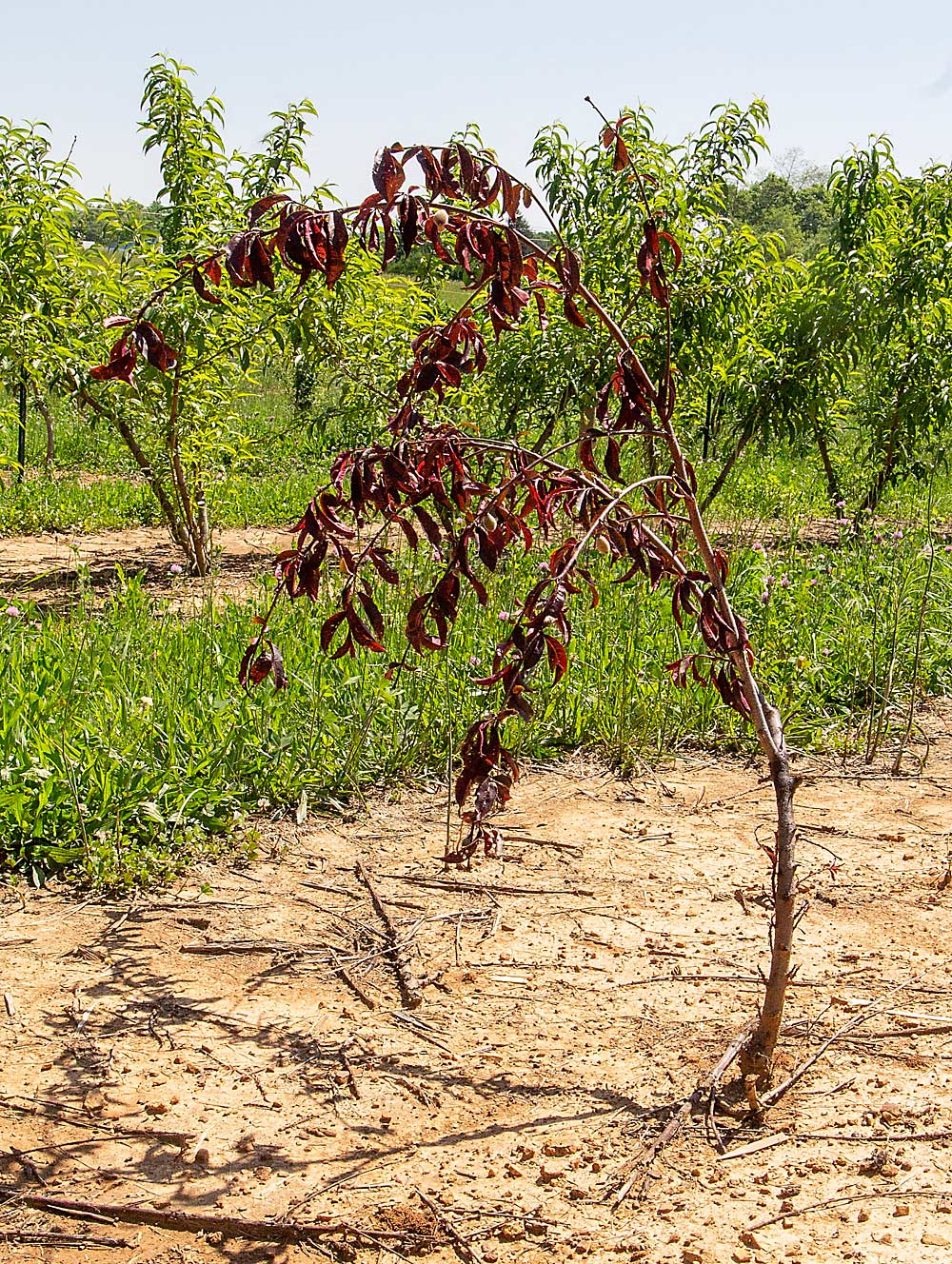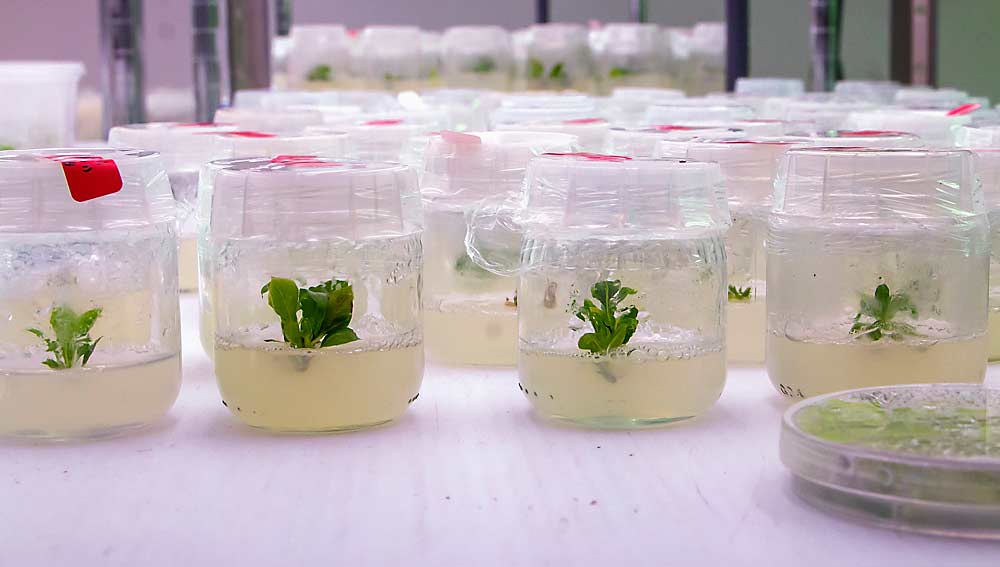
An early flowering gene allows these trees, just 1 year old, to produce fruit for breeding crosses before ever really growing into trees at all. The genetically engineered trait for early flowering is then bred out of the final parents that will be released to breeding programs. (Kate Prengaman/Good Fruit Grower)
In most breeding programs, the misfit plants get tossed to make room for the next generation of potential winners.
But at the U.S. Department of Agriculture’s Appalachian Fruit Research Station in Kearneysville, West Virginia, the unusual-looking trees — plums with every branch growing straight up, dwarf peach trees with narrow leaves, even apples growing fruit while also in bloom — offer insight into how genetics underpin tree architecture.
Researchers here explore, on a fundamental level, what makes a tree a tree, rather than try to create the best new cultivars.
“Our goal isn’t necessarily to generate a new product. It’s to answer some basic science questions about architecture,” said Chris Dardick, lead geneticist for the fruit improvement program. “We don’t really have optimal shaped trees in mind. The idea is we can innovate and create shapes that fit different management systems.”

USDA Appalachian Fruit Research Station geneticist Chris Dardick talks about the potential benefits of a narrow leaf trait, seen here on a dwarf peach tree, that appears to allow better light penetration in the canopy and better photosynthetic efficiency. (Kate Prengaman/Good Fruit Grower)
Understanding which genes control plant architecture, and how, opens the door to everything from peaches naturally suited to high-density plantings or pedestrian systems to plums bred to continuously produce fruit on space missions. Growth habit, bearing positions and pruning needs could all potentially be on the genetic table for modification.
“Today, orchard management is a fight against the nature of the tree,” said Kenong Xu, a Cornell University geneticist who studies the genetics of architecture in apples. While fruit breeders have understandably been focused on fruit quality and disease resistance, mutations that altered plant structure have been key to the improvement of commodity crops such as corn, wheat and rice, he said.
It’s much harder to study and manipulate plant structure in fruit trees — even with modern genetic tools — but researchers say that someday breeders or genetic engineers will be able to use the findings from this research to design more efficient orchards.
“How can we do this to change the tree so that we don’t need to fight it that much?” Xu said. “That would save growers a lot of money.”
Examining peaches and plums
Inspired by the move toward high-density apple orchards, USDA-Kearneysville’s longtime peach breeder, Ralph Scorza, began collecting and crossing ornamental peaches with unique architectures, such as dwarfing, columnar and weeping habits, decades ago.
Before he retired, Scorza released cultivars to growers, including pillar Crimson Rocket and upright Sweet-N-Up, an intermediate structure that carries one copy of the pillar gene instead of two.

These plum trees were genetically engineered to grow straight up. After researchers identified a gene that causes this pillar-type growth in peaches, they wanted to see if the same gene could be altered in plum. Researchers plan to run rudimentary training system experiments to see if the upright structure could offer management benefits, said Dardick. (Kate Prengaman/Good Fruit Grower)
Geneticists identified the gene that conveys the pillar trait, and horticulturists studied the advantages in terms of planting density and light interception, but the cultivars didn’t really catch on. That’s probably because they also have somewhat smaller fruit, Dardick said.
But was the fruit size issue a direct result of the change in architecture or “genetic drag” — an unwanted trait that’s located nearby the desired trait and tends to travel with it during crossbreeding? To find out, they used genetic engineering to transfer that pillar gene into plums, Dardick said, which first bore fruit last summer.
“It was basically all normal, we didn’t see any issues. Which suggests that structural traits are different from the fruiting traits,” he said. “That’s part of the way we are using the biotechnology approach, to ground-truth these traits we are selecting.”
Other traits of interest found in peach include a weeping gene, dwarfing genes and a narrow leaf gene that creates better light penetration in the canopy.
Manipulating the structural genes led to the discovery that branch angle is actually a response to how the plant senses gravity, not light, Dardick said. But that process is then moderated by light and photosynthesis.
It’s actually a universal process of plants: The same genes they found in peach turned out to be responsible for the upright branches and leaves that morphed wild rice and corn into high-yield crops.

A red leaf, weeping peach tree grows at the station in May 2018. Researchers think the red leaf trait could be beneficial if bred into rootstocks, allowing growers to rapidly identify and remove rootstock shoots. (Kate Prengaman/Good Fruit Grower)
Now, researchers plan to put the transgenic plums into training systems to get an idea of the potential benefits and drawbacks of pillar, weeping and semidwarf habits. They’ve also transferred the dwarfing gene from peach into pear rootstocks, to see if they can confer size control without reducing fruit size.
Engineer Amy Tabb will also collaborate with the project, using computer programs she developed to analyze tree architecture to gather data on how the genetic manipulations play out in the orchard.
‘The most exciting thing we’ve seen is that using these genes, we can control the size and shape of the trees in a rational way,” Dardick said. “Using biotechnology, we’ve found that we can change them incrementally, we can get semidwarf trees or not-as-upright trees. It expands the scope of what we can change so we can begin to design the optimal tree as opposed to what’s available.”
The future is not here yet
However, that vision of fruit trees — genetically engineered to have more efficient structure — still remains pretty far away. That’s because for all the mind-boggling wizardry of gene editing innovations, the technology remains limited for fruit trees that are propagated clonally rather than by seed.
“The technology isn’t set up so you can quickly and easily do everything you want,” Dardick said.
Most genetic engineering relies on an agrobacterium to deliver the new genes into a cell. Dardick also includes a gene for antibiotic resistance, so when he tests the resulting cells with an antibiotic, it kills those where the transformation didn’t take. Then he uses tissue culture to propagate the transformed tissue into new trees.
This basic approach works in prune plums and some pear and apple cultivars, but the technology won’t work with peaches for reasons that are not yet clear, Dardick said.
Moreover, wariness about transgenic plants in the food supply remains. That’s why the researchers at the Appalachian Fruit Research Station use genetic engineering to study the genes that control key traits — architecture, dormancy, drought tolerance and disease resistance, to name a few — but not for breeding commercial cultivars.
In one of the station’s greenhouses, transgenic apples that carry an early-flowering gene from birch trees are being used as a tool in the process of breeding resistance to blue mold and fire blight, both from wild apples, into high-quality cultivars. And it’s all being done much more quickly than a traditional breeding program would allow.
Thanks to the early flowering gene, each generation takes just 12 to 18 months, pathologist Jay Norelli said. But that gene is selected out in the final, conventional cross so the resulting parents released to breeders will not contain any genetically modified DNA.

At left, pear rootstocks grow in tissue culture at the Appalachian Fruit Research Station in Kearneysville, West Virginia, in May 2018, following a genetic engineering experiment to see if a gene responsible for dwarfing in peaches will also give the rootstocks size control. (Kate Prengaman/Good Fruit Grower)
Gene editing, or using DNA tools to make a precise change in a gene rather than introducing a new one, is more accepted by the public and regulators, but the challenge is that an agrobacterium still inserts the editing DNA. In plants that are true to seed, a second generation preserves the edit but not the bacteria. For fruit trees, a breeding program still must cross the desired genetic change into a new line for propagation.
Researchers expect someday a new tool will be developed to make gene editing efficient in fruit trees, opening the door to profit from this research by manipulating plant architecture and other traits to create more productive systems. The possibilities are vast.
“A lot of the traits that we think are specific to different species of crops — seasonal flowering, dormancy, being a tree — all these things are not genetically constrained. There’s the potential to convert a tree crop to a nontree crop and vice versa,” Dardick said. “It’s challenging the concept of apples in an orchard.” •
—by Kate Prengaman
Related: Taming traits from the wild genome






Leave A Comment